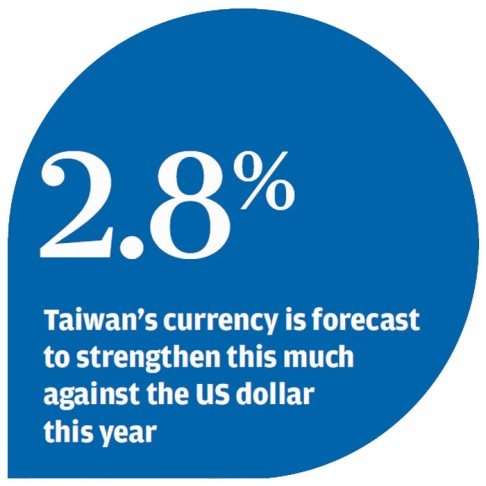
Tide turns in capital flow
Taiwan's tycoons are refocusing their investment attention from the mainland to the island just as the local currency is mounting a revival
Taiwan's tycoons are reining in 20 years of expansion on the mainland to invest at home, pressuring the central bank to stem gains in the local currency as strategists see it rising more than the yuan for the first time since 2007.

"We've been talking about Taiwan's industries hollowing out for 20 years, but this is starting to change," Frances Cheung, a senior strategist at Credit Agricole CIB in Hong Kong, said. "Returning money will help boost the Taiwan dollar."
While Taiwan's central bank intervenes to curb any advance, the capital flows may bolster the island's dollar, which is forecast to appreciate more than the yuan after trailing for five years, surveys of analysts show. After strengthening about 20 per cent from its low in 2009 through last year, the currency has depreciated 2.2 per cent this year, Asia's third-worst performer after the yen and the South Korean won.
Kenda, the world's third-largest maker of bicycle tyres, and Largan, a supplier of camera lenses to Microsoft and Apple, are planning to build more plants in Taiwan after contributing to at least US$125 billion of investment by local companies on the mainland since 1991.
Corporate outflows to the mainland fell 17 per cent to US$10.9 billion last year, according to the Taipei-based Investment Commission.
Taiwanese firms might invest US$8 billion in the island this year, Barclays estimates.
"It's a major trend reversal," Leong Wai Ho, a senior regional economist at Barclays in Singapore, said. "This infusion of investment may reduce the drag on the financial account."
Investment outflows from Taiwan led to a financial-account deficit in seven of the past 10 years. The shortfall in the measure, which is part of the wider balance of payments, increased to US$11.6 billion in the fourth quarter, the most since the same period of 2011, official data shows. The last surplus, amounting to US$5.9 billion, was in the second quarter of 2010.
Taiwan's currency, which is down 0.7 per cent in the past year to NT$29.801, will strengthen 2.8 per cent against the US dollar to NT$29 by the end of this year, according to the median estimate of 25 analysts in a survey. The yuan, which has advanced 1.5 per cent to 6.2128 to the greenback in Shanghai, will climb 1.5 per cent to 6.12, a separate survey of 36 analysts shows.
Largan, based in Taichung, was scouting for a new site for a camera-lens plant in central Taiwan, acting spokeswoman Josephine Huang said.

Kenda, which set up its first facility on the mainland in 1990, planned to spend NT$10 billion on a new car-tyre plant in the western town of Changhua where the company was based, spokesman Liu Kuei-chun said.
Chairman Yang, whose 6.6 per cent stake was valued at NT$2.4 billion, built three factories across the strait in Shenzhen and Tianjin and hired more than 4,000 workers on the mainland since he took over from his father almost two decades ago, Liu said.
The company, which last built a factory on the island 28 years ago, was also turning its back on the mainland as wage costs climbed, Liu said.
Mainland manufacturing workers earned an average monthly income of US$499 in the first nine months of last year, almost double the rate five years earlier, government data shows. Taiwan's minimum wage rose 5 per cent to US$633 in the same period.
Consumer prices on the island rose 2.97 per cent last month from a year earlier, compared with 3.2 per cent on the mainland. The economy on the mainland, Taiwan's biggest export market, will expand 8.1 per cent this year, accelerating from a 13-year low of 7.8 per cent in 2012, according to the median estimate of 45 economists.
"Taiwan has the high level of automation technology desired for some of the more specialised products we make," Liu said. "Accelerating inflation and surging labour costs in China are the main reasons why we want to come back."
Ma's incentives to lure companies back to Taiwan will help boost economic growth by 0.1 percentage point this year, Barclays' Leong estimates. The government predicts gross domestic product will increase 3.59 per cent in the 12 months to December, up from 1.26 per cent last year, while private investment by companies on the island is projected to reach a record NT$2.3 trillion.
While currency appreciation would help temper inflation, the central bank is capping gains in Taiwan's dollar to protect exporters. The Central Bank of the Republic of China (Taiwan) has sold the local dollar in the run-up to the market close on most days in the past year, according to two traders who asked not to be identified because they were not permitted to speak publicly.
The monetary authority would intervene if "irregular factors", such as large fund flows, caused "excessive" volatility, governor Perng Fai-nan told lawmakers on Monday.

